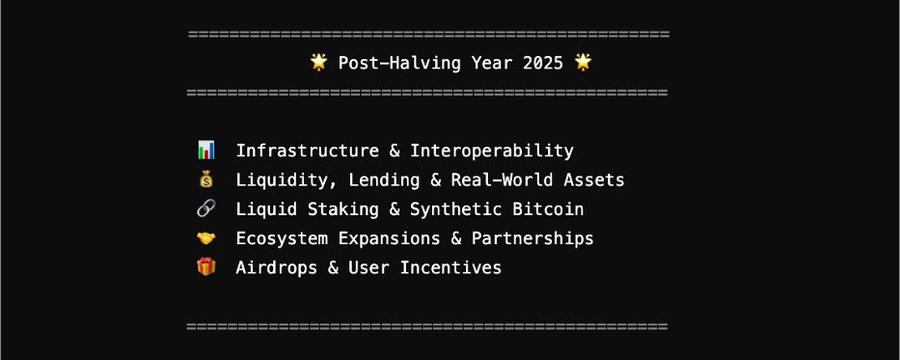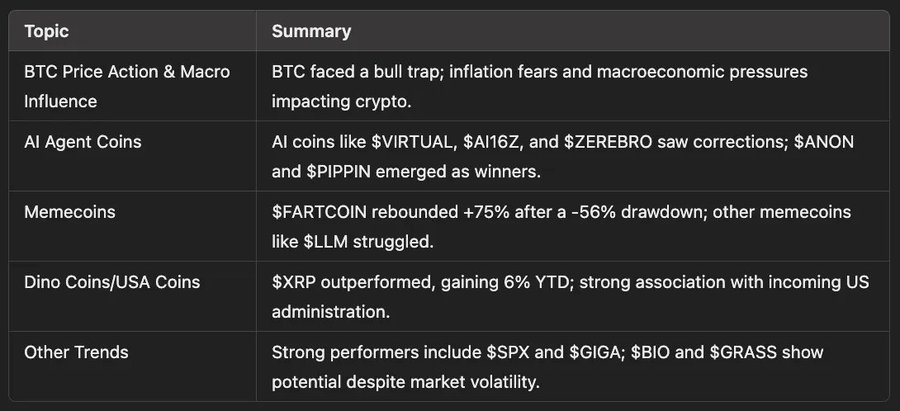This article explores the dynamics and forecasts of the crypto market after the Bitcoin halving, reviewing historical cycles, analyzing market development trends, and looking ahead to the market opportunities and challenges in 2025. This article is based on a piece written by @arndxt_xo, compiled and translated by BlockTempo.
(Background: Who is the winner and who is benefiting behind the issuance of President Trump's MEME coin? What impact does it have on the crypto market? )
(Additional background: Bitcoin surges past $100,000 after CPI data release, is the market turning greedy?)

Historically, Bitcoin has usually performed strongly in February of the year following its halving.
I. Cycle Review and Forecast
1) Review of 2017 and 2021 Cycles
2017: Bitcoin saw a pullback in January but resumed its uptrend in February.
2021: Similarly, BTC declined in January but regained its upward momentum in February.
2) Forecast for 2025
If history repeats itself, February this year may also see a similar bullish run.
3) Market Rumors and Potential Driving Factors
Recently, market speculation about Bitcoin-related executive orders has been heating up.
Although unconfirmed, historical experience suggests that such events often have a significant impact on the market.
Next, we will delve into the performance of various sectors.
II. Industry Overview

1) Infrastructure & Interoperability
Reducing network tribalism and achieving cross-chain connectivity
Development Dynamics:
Superposition (Arbitrum L3) and Abstract (integrating Stargate's Hydra) are launching more efficient asset transfer and data sharing solutions.
The influence of the LayerZero expansion suite is growing, allowing applications on Superposition to access liquidity from over 100 connected chains.
Arcana Network collaborates with Scroll to allow users to pay gas fees in stablecoins (USDC/USDT) on any chain, significantly simplifying the onboarding process.
Perspective:
These developments indicate that the momentum for cross-chain interoperability continues to be strong. From L1 to L2 to L3, seamless asset and data mobility is gradually becoming an industry standard.
Projects that can integrate user-friendly interfaces, gas abstraction, and universal cross-chain bridges are poised to reduce the barriers that have historically hindered DeFi adoption due to "network tribalism".
Followin' the future, we may see more customized L3 launches in vertical domains, such as those focused on gaming, RWA (real-world assets), and institutional-grade DeFi.
2) Liquidity, Lending, and Real-World Assets
The Holy Grail of credit and lending ecosystems
Developments:
Coinbase launched BTC-collateralized loans for US users, providing the mainstream audience with the ability to leverage their Bitcoin assets.
Tradable collaborated with ZKsync to bring $1.7 billion in RWA (real-world assets) on-chain, demonstrating how institutional-grade products are further penetrating the DeFi space.
Plume Network attracted over $4.5 billion in asset commitments for asset tokenization, with a pre-launch TVL of $64 million, and also launched a $25 million RWAfi ecosystem fund.
Insights:
The boundaries between CeFi and DeFi are becoming increasingly blurred, which is an important sign of industry maturation.
Coinbase's entry into the crypto-collateralized lending market indicates that centralized exchanges are willing to offer products traditionally associated with DeFi platforms. This may siphon off DeFi users, but it also validates the importance of on-chain lending as a critical financial tool.
The integration of RWA is seen as the "Holy Grail" for bridging traditional finance and on-chain liquidity.
If this trend continues, DeFi may see stronger yields, deeper liquidity, and higher institutional trust, but it may also come with increased regulatory scrutiny.
The developments in these two areas reflect not only technological and ecosystem progress, but also the industry's transformation from "novel technology" to mainstream financial tools.
3) Liquid Staking & Synthetic Bitcoin
Innovations in staking mechanisms
Developments:
Babylon Labs launched $YBTC, a 1:1 BTC-backed liquid staking token, integrated with pSTAKE.
BrahmaFi launched the Onchain+ program, combining multi-chain strategies and AI agents (ConsoleKit) to automate DeFi operations.
Insights:
Liquid staking has proven to be a key means of unlocking additional rewards for stakers without sacrificing liquidity. By tokenizing staked assets (such as BTC, ETH, etc.), DeFi participants can use them as collateral or trade them freely.
This "dual yield" model (earning staking rewards and potential DeFi yields) is likely to accelerate further development.
However, inherent risks exist: the more an asset is "liquid staked," the deeper the system's complexity. Protocols must maintain transparency and undergo thorough audits to prevent hidden leverage from eroding system stability.
4) Ecosystem Expansion Kits and Strategic Partnerships
Mass user onboarding and enterprise collaborations
Developments:
Polygon Labs partnered with India's largest telecom company, Reliance Jio (with over 450 million users), to integrate blockchain solutions into Jio's applications.
Ledger integrated Uniswap into Ledger Live Desktop, providing a smoother experience for hardware wallet users.
Abstract is preparing for its mainnet, hinting at an upcoming wave of multi-chain product innovations.
Insights:
Mass user onboarding and enterprise collaborations are key to the blockchain industry's mainstream adoption. This not only increases the exposure of blockchain technology but also further validates its value through real-world use cases.
Particularly in high-growth markets like India, Polygon's partnership with Reliance Jio could become an important example of driving blockchain adoption.
5) Airdrops, Incentives, and Liquidity Mining
Intensifying user competition
Developments:
Multiple projects, including Scroll, Quai Network, Fuel, and Bubblemaps, are launching airdrop campaigns or continuing reward seasons, with varying community participation criteria.
Protocols like Vertex (rewarding 2.1 million $SEIToken) and Derive (rewarding 2 million $DRV to liquidity providers) continue to provide user incentives. Nodepay and Solayer offer early claim processes or direct distribution at the TGE stage.
Insights:
Airdrops have proven to be an effective way to bootstrap an initial user base, but they are also gradually becoming a "standard" in the competition among new protocols.
As more projects offer incentives, user fatigue may become an issue. The key for projects is to attract users through genuine utility, not just "incentive chasing."
In the long run, protocols need to find a balance between incentive mechanisms and sustainable token economics. The best strategy is to design a reward system that can attract new users and retain them through the actual product value.
III. Narrative Overview
From liquid staking and ecosystem collaborations to user incentives, the industry's current focus is on enhancing user experience and engagement through innovation and strategy. These developments not only drive the improvement of infrastructure but also mark the gradual maturation and increased efficiency of DeFi.

1) BTC Price Trend and Macroeconomic Impacts
Market Dynamics
On the first Monday of the new year, the market experienced a significant "bull trap." Bitcoin ($BTC) surged sharply after the New York market open, with the Coinbase premium attracting investors who believed the bull market was imminent. However, this signal proved to be false. The next day, Bitcoin prices quickly stagnated and plummeted, with the Altcoin market following suit.
2) Key Macroeconomic Factors Causing Uncertainty
Inflation Concerns: The strong job market data (NFP report) released on January 10th signaled potential inflationary pressures, which could lead to fewer rate cuts, a negative signal for the stock and crypto markets.
US Dollar Index (DXY): Reached a new high of 110.
10-Year Treasury Yield: Risen from 4.6% at the start of the year to 4.8%.
S&P 500 Index: Retested pre-election price levels.
3) AIToken Corrections and Consolidation Opportunities
$VIRTUAL: Declined 57% from a $5.2 billion market cap.
$AI16Z: Declined 63% from a $2.5 billion market cap.
$ZEREBRO: Declined 73% from an $820 million market cap.
$FAI: Dropped from $650 million to $500 million.
$AIXBT: Remained near all-time highs despite the market weakness.
$GOAT: Declined 55%, still performing poorly.
Emerging Winners
$ANON: Grew from $20 million to $240 million.
$AVA: Grew from $60 million to $300 million.
$PIPPIN: Grew from $15 million to $320 million.
IV. Memecoins Dynamics
1) FARTCOIN
A meme coin loosely associated with AI narratives, it rebounded 75% after a 56% decline. The market generally speculates that its market cap could surpass $5 billion or even higher.
$$BUTTHOLE and $$LLM
$BUTTHOLE: Reached a high of $140 million before declining 70%.
$LLM: Related to AI narratives, reached $150 million before declining 75%.
2) Dino Coins and USA Coins (Represented by $XRP)
$XRP: Up 6% year-to-date, outperforming the market.
Ripple's association with the incoming U.S. government and CEO Brad Garlinghouse's relationships with key political figures have boosted market sentiment.
3) Other Strongly Performing Tokens
$HBAR
$XLM
$ADA
V. Other Significant Trend Performances
$SPX: Broke through $1 billion market cap, reached a high of $1.6 billion, and is now down 30%.
$GIGA: Approached $1 billion but faced resistance, down 30%.
$SUI: Reached a historic high FDV of $54 billion, only down 13%.
New Project Launches
$BIO: As the first major DeSci protocol to launch, with an FDV of $3 billion, but is now down 55%.
$GRASS: Showed a strong rebound after experiencing weeks of sideways trading.
$USUAL: Controversial due to changes in the USD0++ redemption rules, down 66% from its all-time high.
Tokens to Watch Out For
$FTM: May have a second spring due to the delisting of trading contracts, but faces significant migration issues.
$RUNE: Facing risks related to ThorFi lending, being compared to LUNA.
Animal-themed meme coins: $POPCAT, $WIF, and $NEIRO performed the worst, with $POPCAT down 73% from its all-time high.
VI. Outlook for 2025
The market has entered a new chapter, but the macroeconomic environment and the diversity of the Token market remind us to remain cautious while seeking out promising opportunities.
Looking forward to reaching new highs in 2025 together with more market participants!








